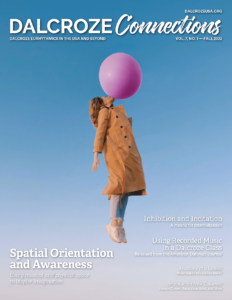
Guest Editor’s Letter
Participating in a good eurhythmics class can be a bit like watching a great movie. The director’s filmmaking technique, when it is masterful, disappears once you are swept up in the flow of the movie. It’s only when we emerge from the film that we can marvel at the way it was put together: the camera angles, the lighting, the imagery that foreshadowed a major turn of events…
Of course, we can study how the film was made, just as we can pick apart the details of a well-executed Dalcroze class. We can examine the sequence of activities that led the students toward mastery with gradually increasing levels of challenge. We can notice how the teacher adjusted her piano improvisation to match the abilities (and perhaps deficiencies) of the class. We can also describe the different kinds of strategies the teacher employed to give the students a healthy variety of experiences in the subject of the day. While the teacher’s lesson plan and her improvisations may be tied to a particular class, it is possible to generalize and delineate the exact techniques used in Dalcroze education. I’m talking about the canons, the reaction and improvisation games, the use of group activities, and all the rest that comprise the basic set of strategies used worldwide by Dalcroze teachers.

For a list of these “nuts and bolts” of Dalcroze teaching as put together by the Dalcroze Society of America’s Professional Development Committee, have a look on page 9 of the “Dalcroze Professional Certificate and Dalcroze License Teacher Training Program” (affectionately known as “The T 2 Manual”). You can download it at dalcrozeusa.org/T2.
For the next two issues of Dalcroze Connections, members of this committee will be sharing ways they use a few of these teaching techniques.
In the current volume, I describe some recent discoveries on how to use space itself as a teaching technique. Did you cue up the Star Trek theme in your head as you read that? If so, you are using incitation and inhibition, a teaching strategy Jeremy Dittus and Eiko Ishizuka explain on page 16. While this particular technique may sound rather alien, even if you’ve only been to one Dalcroze class in your life, odds are your teacher used it! Read their highly informative and practical article to find out more.
The DSA is constantly adding resources to a library that includes articles like these, as well as videos, lesson plans, and back issues of both Dalcroze Connections and the American Dalcroze Journal to keep teachers and students alike inspired. Watch for the spring issue and the blog for more of the same.
Got a quick reaction to something you read in the magazine? Got an idea for something you like to read? We’d love to hear from you! Drop us a line at editor@dalcrozeusa.org.
This article was originally published in the Fall 2022 issue of Dalcroze Connections, Vol. 7 No. 1.